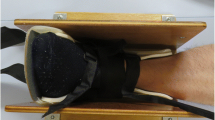Abstract
Greater trochanter (GT) stabilization techniques following a fracture or an osteotomy are still showing high levels of postoperative complications. Understanding the effect of femoral neck cut placement, cable tension and muscles forces on GT fragment displacements could help surgeons optimize their techniques. A 3D finite element model has been developed to evaluate, through a statistical experimental design, the impact of the above variables on the GT fragment gap and sliding displacements. Muscles forces were simulating typical daily activities. Stresses were also investigated. The femoral neck cut placement had the most significant effect on the fragment displacement. Lowering it by 5 mm increased the gap and sliding fragment displacements by 288 and 128 %, respectively. Excessive cable tightening provided no significant reduction in fragment displacement. Muscle activities increased the gap and the sliding displacements for all muscle configurations. The maximum total displacement of 0.41 mm was present with a 10 mm femoral neck cut, a cable tension of 178 N, and stair climbing. Caution must be used not to over tighten the cables as the potential damage caused by the increased stress is more significant than any reduction in fragment displacement. Furthermore, preservation of the contact area is important for GT stabilization.



Similar content being viewed by others
References
Barrack RL, Butler RA (2005) Current status of trochanteric reattachment in complex total hip arthroplasty. Clin Orthop Relat Res 441:237–242
Box G, Hunter W, Hunter J (1978) Statistics for experimenters. Wiley, New York
Bourgeois Y, Petit Y, Laflamme GY (2010) Finite element model of a greater trochanteric reattachment system. Conf Proc IEEE Eng Med Biol Soc 2010:3926–3929
Canet F, Duke K, Bourgeois Y, Laflamme GY, Brailovski V, Petit Y (2011) Effect of force tightening on cable tension and displacement in greater trochanter reattachment. Conf Proc IEEE Eng Med Biol Soc 2011:5749–5752
Cheung G, Zalzal P, Bhandari M, Spelt JK, Papini M (2004) Finite element analysis of a femoral retrograde intramedullary nail subject to gait loading. Med Eng Phys 26:93–108
Clarke RP, Shea WD (1979) Trochanteric osteotomy: analysis of pattern of wire fixation failure and complications. Clin Orthop Relat Res 141:102–110
Dall DM, Miles AW (1983) Re-attachment of the greater trochanter: the use of the trochanter cable-grip system. J Bone Joint Surg Br 65:55–59
Heiner AD, Brown TD (2001) Structural properties of a new design of composite replicate femurs and tibias. J Biomech 34:773–781
Heller MO, Bergmann G, Kassi JP, Claes L, Haas NP, Duda GN (2005) Determination of muscle loading at the hip joint for use in pre-clinical testing. J Biomech 38:1155–1163
Hersh CK, Williams RP, Trick LW, Lanctot D, Athanasiou K (1996) Comparison of the mechanical performance of trochanteric fixation devices. Clin Orthop Relat Res 329:317–325
Markolf KL, Hirschowitz DL, Amstutz HC (1979) Mechanical stability of the greater trochanter following osteotomy and reattachment by wiring. Clin Orthop Relat Res 141:111–121
McCarthy JC, Bono JV (1999) The outcome of trochanteric reattachment in revision total hip arthroplasty with a Cable Grip System: mean 6-years follow-up. J Arthroplasty 14:810–814
McLean RA, Anderson VL (1984) Applied factorial and fractional designs. Marcel Dekker, New York
Polgar K, Viceconti M, O’Connor JJ (2001) A comparison between automatically generated linear and parabolic tetrahedra when used to mesh a human femur. Proc Inst Mech Eng Part H J Eng Med 215:85–94
Plausinis D, Speirs AD, Masri BA, Garbuz DS, Duncan CP, Oxland TR (2003) Fixation of trochanteric slide osteotomies: a biomechanical study. Clin Biomech 18:856–863
Ritter MA, Eizember LE (1991) Trochanteric fixation by cable grip in hip replacement. J Bone Joint Surg Br 73:580–581
Schwab JH, Camacho J, Kaufman K, Chen Q, Berry DJ, Trousdale RT (2008) Optimal fixation for the extended trochanteric osteotomy: a pilot study comparing 3 cables vs 2 cables. J Arthroplasty 23:534–538
Viceconti M, Bellingeri L, Cristofolini L, Toni A (1998) A comparative study on different methods of automatic mesh generation of human femurs. Med Eng Phys 20:1–10
Viceconti M (2005) Extracting clinically relevant data from finite element simulations. Clin Biomech 20:451–454
Zalzal D, Gross AE, Papini M (2006) Notching of the anterior femoral cortex during total knee arthroplasty characteristics that increase local stresses. J Arthroplasty 21:737–743
Author information
Authors and Affiliations
Corresponding author
Rights and permissions
About this article
Cite this article
Petit, Y., Cloutier, L.P., Duke, K. et al. The effects of femoral neck cut, cable tension, and muscles forces on the greater trochanter fixation. Med Biol Eng Comput 50, 411–417 (2012). https://doi.org/10.1007/s11517-012-0892-x
Received:
Accepted:
Published:
Issue Date:
DOI: https://doi.org/10.1007/s11517-012-0892-x




